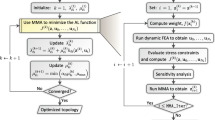Abstract
The paper deals with the imposition of local stress constraints in topology optimization. The aim of the work is to analyze the performances of an alternative methodology to the ε-relaxation introduced in Cheng and Guo (Struct Optim 13:258–266, 1997), which handles the well-known stress singularity problem. The proposed methodology consists in introducing, in the SIMP law used to apply stress constraints, suitable penalty exponents that are different from those that interpolate stiffness parameters. The approach is similar to the classical one because its main effect is to produce a relaxation of the stress constraints, but it is different in terms of convergence features. The technique is compared with the classical one in the context of stress-constrained minimum-weight topology optimization. Firstly, the problem is studied in a modified truss design framework, where the arising of the singularity phenomenon can be easily shown analytically. Afterwards, the analysis is extended to its natural context of topology bidimensional problems.
Similar content being viewed by others
References
Achtziger W (2000) Optimization with variable set of constraints and an application to truss design. Comput Optim Appl 15(1):69–96
Bendsøe M (1989) Optimal shape design as a material distribution problem. Struct Optim 1:193–202
Bendsøe M, Kikuchi N (1988) Generating optimal topologies in structural design using a homogeneization method. Comput Methods Appl Mech Eng 71(2):197–224
Bendsøe M, Sigmund O (1999) Material interpolation schemes in topology optimization. Arch Appl Mech 69(9):635–654
Bendsøe M, Sigmund O (2003) Topology optimization—theory, methods and applications. Springer, Berlin Heidelberg New York
Bruggi M, Venini P (2007) A mixed FEM approach to stress-constrained topology optimization. Int J Numer Methods Eng doi:10.1002/nme.2138
Cheng GD (1995) Some aspects of truss topology optimization. Struct Optim 10:173–179
Cheng GD, Guo X (1997) ε-relaxed approach in topology optimization. Struct Optim 13:258–266
Cheng GD, Jiang Z (1992) Study on topology optimization with stress constraints. Eng Optim 20:129–148
Cheng GD, Wang B (2007) Constraint continuity analysis approach to structural topology optimization with frequency objective/constraints. In: 7th world congress on structural and multidisciplinary optimization, pp 2073–2079
Dorn WS, Gomory RE, Greenberg HJ (1964) Automatic design of omptimal structures. J Méc 3:25–52
Duysinx P, Bendsøe MP (1998) Topology optimization of continuum structures with local stress constraints. Int J Numer Methods Eng 43(8):1453–1478
Duysinx P, Sigmund O (1998) New developments in handling stress constraints in optimal material distribution. In: 7th symposium on multidisciplinary analysis and optimization AIAA–98–4906:1501–1509
Guo X, Cheng, GD, Yamazaki K (2001) A new approach for the solution of singular optima in truss topology optimization with stress and local buckling constraints. Struct Multidisc Optim 22(5):364–373
Johnson C, Mercier B (1978) Some equilibrium finite elements methods for two dimensional elasticity problems. Numer Math 30:103–116
Kirsh U (1990) On singular topologies in optimum structural design. Struct Optim 2:133–142
Pereira JT, Fancello EA, Barcellos CS (2004) Topology optimization of continuum structures with material failure constraints. Struct Multidisc Optim 26:50–66
Petersson J (2001) Some convergence results in perimeter-controlled topology optimization. Int J Eng Sci 39:1119–1141
Querin OM, Steven GP, Xie YM (2000) Evolutionary structural optimization using additive algorithm. Finite Elem Anal Des 34:291–308
Rozvany GIN (1996) Difficulties in truss topology optimization with stress, local buckling and system stability constraints. Struct Optim 11:213–217
Rozvany GIN (2001) On design-dependent constraints and singular topologies. Struct Multidisc Optim 21:164–172
Rozvany GIN, Birker T (1994) On singular topologies in exact layout optimization. Struct Optim 8:228–235
Rozvany GIN, Sobieszczanski-Sobieski J (1992) New optimality criteria methods: forcing uniqueness of the adjoints strains by corner-rounding at constraints intersections. Struct Optim 4:244–246
Rozvany GIN, Zhou M, Birker T (1992) Generalized shape optimization without homogenization. Struct Optim 4:250–254
Sigmund O (1994) Design of material structure using topology optimization. Ph.D. thesis, Department of Solid Mechanics, Technical University of Denmark
Stolpe M (2003) On models and methods for global optimization of structural topologies. Ph.D. thesis, Royal Institute of Technology, Stockholm, Sweden
Stolpe M, Svanberg K (2001) On the trajectory of the ε-relaxation approach for stress-constrained truss topology optimization. Struct Multidisc Optim 21:140–151
Stolpe M, Svanberg K (2003) Modelling topology optimization problems as linear mixed 0 − 1 programs. Int J Numer Methods Eng 57:723–739
Svanberg K (1987) Method of moving asymptotes—a new method for structural optimization. Int J Numer Methods Eng 24(3):359–373
Sved G, Ginos Z (1968) Structural optimization under multiple loading. Int J Mech Sci 10:803–805
Swan CC, Arora JS (1997) Topology design of material layout in structured composite of high stiffness and high strength. Struct Optim 13:45–59
Yang RJ, Chen CJ (1996) Stress-based topology optimization. Struct Optim 12:98–105
Yang RJ, Chuang CH (1994) Optimal topology design using linear programming. Comput Struct 52(2):265–275
Zhou M, Rozvany GIN (1991) The COC algorithm, Part II: topological, geometrical and generalized shape optimization. Comput Methods Appl Mech Eng 89:309–336
Author information
Authors and Affiliations
Corresponding author
Rights and permissions
About this article
Cite this article
Bruggi, M. On an alternative approach to stress constraints relaxation in topology optimization. Struct Multidisc Optim 36, 125–141 (2008). https://doi.org/10.1007/s00158-007-0203-6
Received:
Accepted:
Published:
Issue Date:
DOI: https://doi.org/10.1007/s00158-007-0203-6




